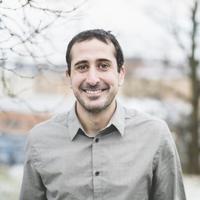Glide symmetries were employed for electromagnetic purposes during the 60s and 70s. Those works were focused on one-dimensional structures with potential application in low-dispersive leaky wave antennas. However, the development of planar/printed technologies in the 80s and 90s associated to their low-cost for low-frequency applications, the studies of glide symmetries stopped.
In the beginning of the 21st century, with arrival of metamaterials, there was a significant development of the understanding of periodic structures, and new methods of analysis were introduced. This theoretical development, together with the interest of industry in mm-waves, particularly for communications systems such as 5G/6G, created an opportunity to explore the possibilities of glide symmetries, especially in two-dimensional configurations.
Glide-symmetric structures has recently attracted the attention of researchers due to their attractive properties for practical applications. Among their interesting properties are low-dispersive responses in fully metallic structures such as parallel plate or co-planar waveguides (CPW), bandgaps associated to the symmetries and large electromagnetic bandgaps (EBGs).
In this talk, I will describe the most significant works in glide symmetries, including their application for the design of gap-waveguide technology and planar lens antennas with steerable angles of radiation.
Keynote Speech Prof. Oscar Quevedo-Teruel (Royal Institute of Technology - KTH) - Glide symmetries: a new degree of freedom for the design of periodic
IEEE ICTfest 2022
Glide symmetries were employed for electromagnetic purposes during the 60s and 70s. Those works were focused on one-dimensional structures with potential application in low-dispersive leaky wave antennas. However, the development of planar/printed technologies in the 80s and 90s associated to their low-cost for low-frequency applications, the studies of glide symmetries stopped.
In the beginning of the 21st century, with arrival of metamaterials, there was a significant development of the understanding of periodic structures, and new methods of analysis were introduced. This theoretical development, together with the interest of industry in mm-waves, particularly for communications systems such as 5G/6G, created an opportunity to explore the possibilities of glide symmetries, especially in two-dimensional configurations.
Date and Time
Location
Hosts
Registration
-
 Add Event to Calendar
Add Event to Calendar
- Contact Event Hosts
-
Chair: Anna Litviņenko anna.litvinenko@rtu.lv
- Survey: Fill out the survey
Speakers
 Prof. Oscar Quevedo-Teruel
Prof. Oscar Quevedo-Teruel
Glide symmetries: a new degree of freedom for the design of periodic structures
Biography:
Oscar Quevedo-Teruel is a full professor in the School of Electrical Engineering and Computer Science at KTH Royal Institute of Technology, Stockholm, Sweden, and director of the Master Programme in Electromagnetics, Fusion and Space Engineering and responsible of the Antenna Laboratory. He has been an Associate Editor of the IEEE Transactions on Antennas and Propagation since 2018 and is the founder and editor-in-chief of the journal Reviews of Electromagnetics since January 2021. He was the EurAAP delegate for Sweden, Norway, and Iceland from 2018-2020 and he has been a member of the EurAAP Board of Directors since January 2021. He is a distinguished lecturer of the IEEE Antennas and Propagation Society for the period of 2019-2021 and Chair of the IEEE APS Educational Initiatives Programme since 2020. He has made scientific contributions in the fields of lens antennas, metasurfaces with higher symmetries and transformation optics. He has co-authored over 100 papers in international journals, over 160 at international conferences, and has received approval on 3 patents.
Address:KTH Royal Institute of Technology, , Stockholm, Stockholms lan, Sweden
Agenda
RTU, Zunda krastmala 10, room 104, Riga
09:00 - 09:30 Registration
9:30 - 09.45 IEEE Day & ICTfest Celebration Opening
09:45 - 10.30 Keynote Speech Prof. Yury Shestopalov (Högskolan i Gävle) - Resonance scattering and cloaking: unified mathematical approach and model
10:30 – 11:15 Keynote Speech Prof. Oscar Quevedo-Teruel (Royal Institute of Technology - KTH) - Glide symmetries: a new degree of freedom for the design of periodic structures
11:15 - 12.00 Keynote Speech Prof. Dr.-Ing. Ingo Gaspard (Hochschule Darmstadt – University of Applied Sciences) - Measurement, modelling and simulation of polarization properties of the indoor radio channel at microwave frequencies and below
14:30 - 18.30 IEEE Lithuania and Latvia Sections Workshop on Microwave Device and Systems
19.00 - 21.00 Organization Committee meeting of IEEE Lithuania and Latvia Sections Workshop on Microwave Device and Systems
IEEE ICTfest 2022

